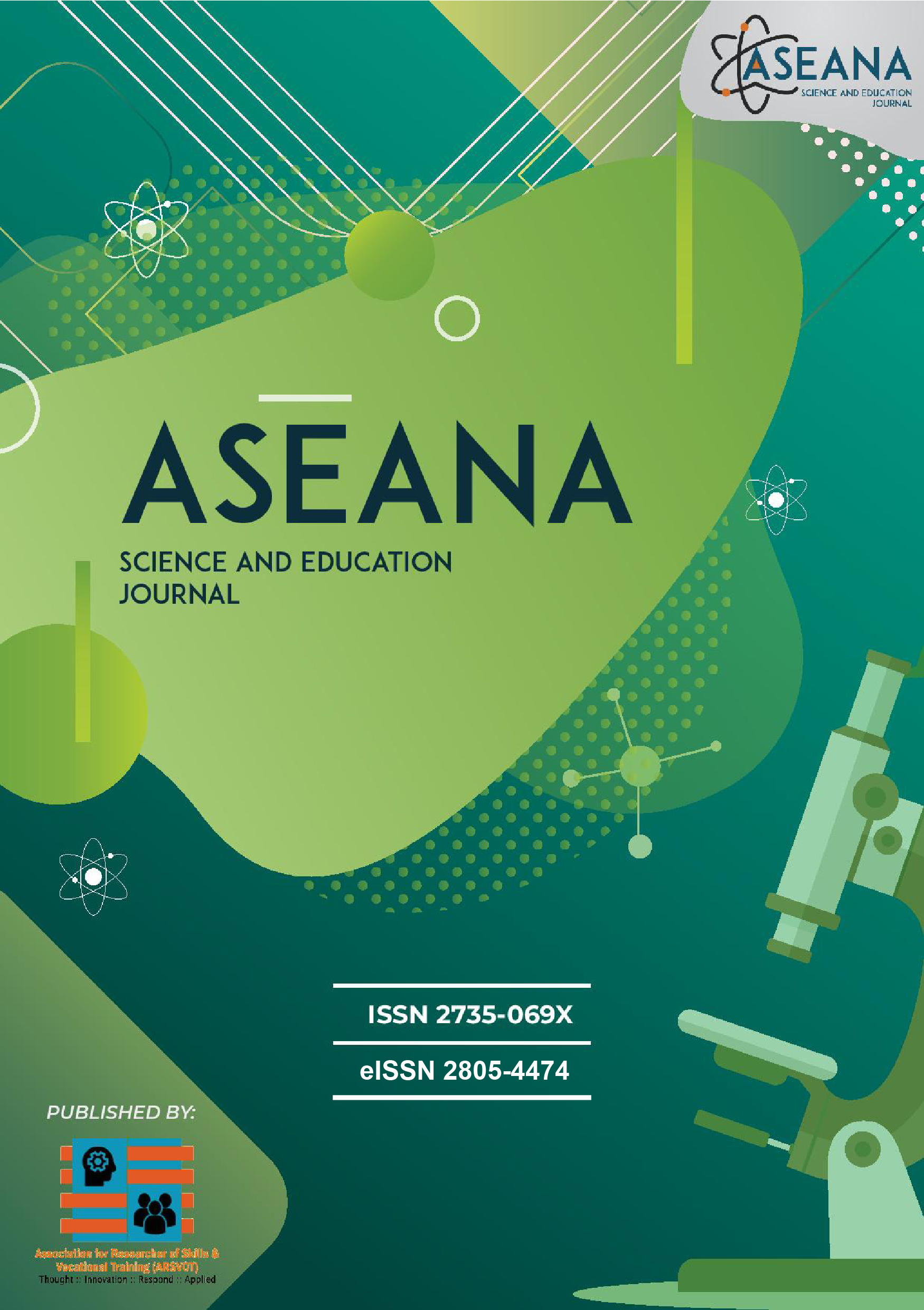A Study on The Effective Use of Microorganisms using Different Amounts of Mudball and Wastewater Retention Time
DOI:
https://doi.org/10.53797/aseana.v5i1.1.2025Keywords:
Wastewater, retention time difference, organic matter, wastewater sampleAbstract
Wastewater treatment is important before water sources are polluted where it needs to be treated to prevent water pollution before the water returns to the environment. Inadequate sewage systems cause rivers to be polluted and make them open sewers, which are discharged directly into the river which will affect the environment, human health and quality of life. Therefore, a study on the Use of Effective Microorganisms using different amounts of mudballs and wastewater retention times was carried out. This was to see the potential of treating wastewater from oxidation ponds using Effective Microorganisms (EM) mudballs as a treatment method. The scope of this study was to determine the organic matter present in wastewater samples and EM mudballs that act to treat wastewater taken from oxidation ponds and analyzed in the laboratory. The data obtained was analyzed according to a certain number of days for a month using EM mudballs as treatment materials. Five parameters were analyzed including pH, biochemical oxygen demand (BOD), chemical oxygen demand (COD), dissolved oxygen (DO) and Ammonia Nitrogen (AN). The process of determining the appropriate dose of EM mudballs for treatment can be determined by using 1 to 4 EM mudballs. The retention time for the treatment period was monitored for a month, on days 7, 14, 21 and 28. The wastewater study process was carried out using an aquarium as a prototype. The results of the study showed that the use of 1 EM mudball was sufficient for the short-term treatment process, on day 7. In this study, the use of 4 mudballs was determined as the best dose because it had the highest BOD, COD and AN removal effectiveness. Bacterial growth determination could be detected from day 1 to day 28. Therefore, it can be concluded that this treatment process has the potential to be utilized because the parameters that were tested could be removed effectively.
Downloads
References
Abdullah, M.M.A.B, Ghazali, C.M.R, Hussin, K. Kamal, S.Z, Sahari, M.J, Sabran, S dan Zawawi, Z (2011). Multipurpose EM SMaRT-Ball.UniMAP Patent 2011000970
A.Okuda dan T.Higa, (1997), Purification of Wastewater with Effective Microorganisma and its Utilazation in Algiculture, University of theRyukyus Okinawa, Japan
Dobrzy´ nski, J.; Kulkova, I.; Wierzchowski, P.S.;Wróbel, B. (2022). Response of Physicochemical and Microbiological Properties to the Application of Effective Microorganisms in theWater of the Turawa Reservoir. Water 2022, 14, 12. https://doi.org/10.3390/w14010012
Dr Higa, T dan Chinen, N, (1998). EM Treatment of Odor, Wastewater and Environment Problems.
Dr U.R. Sangakkara, (2000). The Technology of Effective Microorgnism- Case study of Application, Sri Lanka.
Fadjari Lucia Nugroho, Deni Rusmaya, Yonik Meilawati Yustiani, Fajar Ibnil Hafiz and Runie Besty Teta Putri, (2016). Effect Of Temperature On Removal Of Cod And Tss From Artificial River Water By Mudballs Made From Em4, Rice Bran And Clay * Faculty of Engineering, Pasundan University, Indonesia International Journal of GEOMATE, May, 2017, Vol.12, Issue 33, pp.91-95 Geotec., Const. Mat. & Env., ISSN:2186-2990, Japan, DOI: http://dx.doi.org/10.21660/2017.33.2626
Fadjari Lucia Nugroho Deni Rusmaya and Muthia Damayanti (2018). Comparison Of Cod and Tss Removals From Artificial River Water By Mudballs Made With Activated Em1 And Em4 Solutions, International Journal of GEOMATE, March, 2019 Vol.16, Issue 55, pp. 28 - 33 ISSN: 2186-2982 (P), 2186-2990 (O), Japan, DOI: https://doi.org/10.21660/2019.55.4539. Special Issue on Science, Engineering & Environment 28.
Jabatan Alam Sekitar (1991) Pencemaran Air .Unit Perkhidmatan Maklumat, JAS. Malaysia.
Malaysia Environmental Quality Report. (2010). Pollution Sources Inventory. Jabatan Alam Sekitar.
Monica, S, Karthik, L, Mythili, S, &Sathiavelu, A. (2011). Formulation of Effective microbial Consortia and its Application for sewage treatment. J microbial BiochemTechnol, http://dx.doi.org/10.4172/1948-5948.1000051
S.H Mun Wei & T. Swee Sen (2021). Investigation on the Efficiency of Effective Microorganisms for Polluted Water Treatment. Applied Microbiology: Theory & Technology. http://ojs.wiserpub.com/index.php/AMTT.
Nathan Szymanski, Robert A Patterson (2003). Effective microorganism (EM) and Wastewater System, University of New Zealand, Armidale 30th September to 2nd October 2003, Future Directions for On-site System: Best Management Practice Proceedings of On-site 03 Conference.
Noor Azwita Awang Besar (2009). Keberkesanan pengunaan microorganism efektif (effective Mincroorganisma –E.M) dalam pemuliharaan sungai Sebulung.Universiti Teknologi Malaysia: Tesis Sarjana Muda.
Park GS, Khan AR, Kwak Y, Hong SJ, Jung BK, Ullah I, Kim JG, Shin JH (2016) An improved effective microorganism (EM) soil ball-making method for water quality restoration. Environ Sci Pollut Res. 23(2):1100–1107. https://doi.org/10.1007/s11356-015-5617-x
Pinky A. Gumogda (2022) Modified Mudball-Effective Microorganism As Laundry Wastewater Cleansing Agent, Psych Educ, 2022, 5: 850-861, Document ID: PEMJ378, doi: 10.5281/zenodo.7364125, ISSN 2822-4353
Safwat, S.M., Matta, M.E. Environmental applications of Effective Microorganisms: a review of current knowledge and recommendations for future directions. J. Eng. Appl. Sci. 68, 48 (2021). https://doi.org/10.1186/s44147-021-00049-1
Widdina G.N, (2000). Preliminary Experiment of EM Technology on Wastewater Treatment. Indonesian Kyusei Nature Farming Society, Indonesia.
Zarina Zawawi (2010) Multipurpose EM SMaRT-Ball. Universiti Malaysia Perlis: Tesis Sarjana
Downloads
Published
How to Cite
Issue
Section
License
Copyright (c) 2025 Noor Assikin Abd Wahab, Mohd Lotfi Ahmad

This work is licensed under a Creative Commons Attribution-NonCommercial-ShareAlike 4.0 International License.



